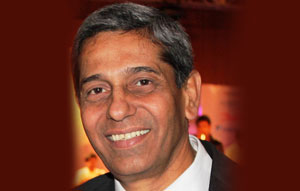Dipak Barma, National President, Indian Society of Heating, Refrigerating & Air Conditioning Engineers (ISHRAE)
Dipak Barma is a confident man. An alumnus of IIT-Kharagpur, Barma, the National President of the Indian Society of Heating, Refrigerating & Air Conditioning Engineers (ISHRAE) has successfully designed and executed many prestigious projects across India and overseas, and is on a mission to take the Indian heating, ventilation and air conditioning (HVAC) sector to greater heights. In this exclusive interaction with MANAS R BASTIA, he opens up on an array of topics from green technologies and energy-efficient buildings to creating a common standard for testing and rating of all HVAC products....
What are the important trends and technologies impacting the Indian HVAC sector?
The trend worldwide is to go for energy-efficiency in HVAC equipment and systems. The effort by manufacturers to develop innovative energy-efficient products has gone up manifold in recent years. It is expected that the number of air-conditioners in India will reach 200 million by 2030, about 40 times the present number installed. This will translate into a power requirement at the grid of 50 terra watt-hour, nearly 10 times the present requirement.
The growth in the tertiary sector has greatly boosted the entire MEP (mechanical, electrical and plumbing) sector. This contributes towards all the service requirements of buildings. HVAC is the single-most major contributor in the services sector. Globally, buildings account for about 40-50 per cent of the total energy consumption; of this, 30-40 per cent is consumed by air-conditioning.
What are the global benchmarks followed for performance measurement in HVAC, especially for the housing and construction sector?
At present, there is no clearly acceptable global standard for performance measurement of all components of the HVAC system. The system parameters for performance certifications have perforce to be different as performance is dependent on ambient temperature and humidity. The conditions are vastly different for differing regions of the world. The standards, therefore, were developed by different countries suiting local conditions. Till now, we have generally been following the US standards for certification and selecting performance criteria for chillers and unitary air-conditioners. These conditions are not at all suitable for the ambient conditions of our country under which the units have to work. The capacities certified for machines require to be de-rated for selecting them for operation in India. No specific system of de-rating is available and every manufacturer follows its own empirical standards resulting in unequal comparisons.
ISHRAE, along with RAMA (Refrigeration and Air-Conditioning Manufacturers' Association) has taken up the mantle of developing the standards for testing and rating of equipment based on the Indian ambient conditions.
The standards for testing and rating of chillers have already been developed and are being released shortly. ISHRAE and RAMA are also coordinating with the Bureau of Energy Efficiency (BEE) and Bureau of Indian Standards (BIS) to adopt and use these standards for the rating of chillers available or manufactured in India. The next set of standards that is being taken up is for VRV (variable refrigerant volume) or VRF (variable refrigerant flow) system of air-conditioners. The plan is to develop and adopt standards suitable to our conditions covering all HVAC equipment over the next one to two years.
How do you see the growing contribution of the construction segment to the HVAC market in India?
The construction industry is probably the single largest contributor to the growth of the HVAC sector. Business analysts report that economic growth, increase in construction activities owing to rise in population, rapid urbanisation and higher disposable income are the key factors driving the growth of the HVAC market. The CAGR of the HVAC industry is projected to be 16.9 per cent till 2015 and volumes are expected to touch 5 million TR during this period. Tighter regulations coupled with stricter enforcement of norms in the sector will attract foreign players to the market and this would put growth in even higher gear.
How has the growing awareness towards greener technologies affected the HVAC industry in India?
Green and energy-efficient technologies are the mantra of the HVAC sector. The need to reduce energy usage has been understood by the industry. ISHRAE has done its bit and still continues to push for improvements to make HVAC systems more green. The focus for ISHRAE's signature international exposition ACREX India 2014 is 'Carbon Neutral' as well as 'Carbon Offsetting'. The dream of achieving all upcoming building projects with net-zero carbon footprint is not very far and is achievable.
What is the need of the hour to popularise energy-efficient buildings?
The need to popularise energy-efficient buildings cannot be overemphasised. Only with the advent of green buildings and energy conservation can we expect to reverse the trend of global warming. It is very heartening to note that a lot of effort is being put in towards this aspect. But the efforts need to be ramped up. Many universities are doing research to work out the properties of building materials used in upcoming projects. In this regard, very good work is being done at CEPT University in Ahmedabad, and ISHRAE is supporting the venture. The Government also requires to ramp up its efforts to implement policies and guidelines to ensure that proper materials are used and the energy usage of buildings is kept within achievable maximum limits. The standards published such as the National Building Code (NBC) and the Energy Conservation Building Code (ECBC) should be updated regularly keeping pace with the development of new material as well as research data on existing materials that is being published. The implementation of the codes also needs to be ensured by proper legislation as required and constant 'check-and-rectify' procedures. ISHRAE has been working to develop and update the codes and standards along with BEE and other government agencies.
What is the role of ISHRAE in this regard?
ISHRAE has a very important role to play. As a society, it has about 10,500 HVAC and MEP professionals on its membership rolls. In association with various authorities, it can provide a huge depth of knowledge and skill-sets to arrive at standards and mandatory requirement levels for all aspects of HVAC and MEP services.
ISHRAE has been working in close coordination with BEE and BIS and providing inputs as and where required from its great depth of experience-based knowledge. The society is represented in the expert committee formed to update the ECBC under the aegis of BEE. The society has also undertaken studies and surveys to establish the temperature and humidity conditions of cities to utilise the same for load estimation design as well as the functioning and power utilisation of different usage buildings in the different temperature zones of the country. These studies help in closer and more accurate estimation, leading to better design and ultimately saving power and reducing carbon footprint.
What has ISHRAE done to impart training for skill upgrade in the HVAC sector?
We conduct Workshops, seminars, technical talks and product presentations for professional members and non-members in the field of HVAC and MEP services.
The society also offers certification courses under the banner of 'ISHRAE Institute of Excellence'. These courses develop human-resource skill sets not only for design, installation and commissioning of the equipment but for maintenance services for proper operation and maintenance of the HVAC equipment and systems.
ISHRAE has a list of special faculty available on an all-India basis called 'Distinguished Lecturers'.
These volunteers from the industry provide and share their knowledge and experiences for the distribution and insemination of sciences involved with HVAC and MEP services. With 39 chapters or sub chapters and student chapters exceeding 100, ISHRAE is able to reach out to pretty much the entire country for such sessions.
Engineering colleges in India do not have a distinct and dedicated course for HVAC in their curriculum. Engineering graduates passing out of various colleges need to brush up their knowledge to be able to cope with the requirements of this industry. This gap has to be fulfilled and ISHRAE tries to do its best to do so.
Cool Facts!
- The CAGR of the Indian HVAC industry is projected to be 16.9 per cent till 2015.
- Air-conditioners in India will reach 200 million by 2030, about 40 times the present number installed.
- The standards for testing and rating chillers are to be released shortly.
- Globally, buildings account for about 40-50 per cent of the total energy consumption; of this, 30-40 per cent is consumed by air-conditioning.
- The worldwide trend is towards energy-efficient HVAC equipment and systems.
- ISHRAE has about 10,500 HVAC and MEP professionals as its members.
To share your views on India’s HVAC sector, write in at feedback@ASAPPmedia.com


















